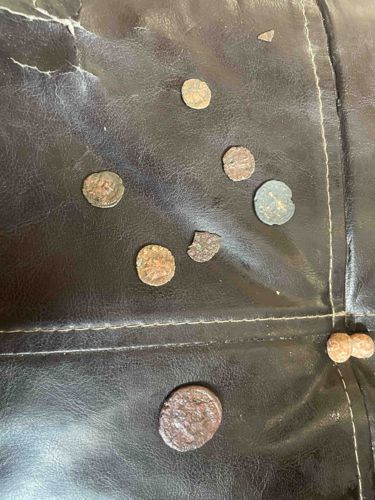
Collection of Ancient or Medieval Coins and Fragments
This collection consists of approximately nine individual metallic objects, predominantly circular and flattened, consistent with ancient or medieval coinage, along with a few smaller, irregular fragments. The items vary in size, with the largest coin appearing to be roughly 2-3 cm in diameter and the smallest fragments less than 1 cm. The prevailing color of the objects is a muted, oxidized brown or dark gray, suggesting an extended period of burial or exposure to environmental elements. This coloration is typical of bronze, copper, or possibly low-grade silver alloys that have undergone significant corrosion. Surface details are largely obscured by heavy patination and wear, but some pieces faintly show what appear to be traces of portraits, inscriptions, or governmental symbols, indicative of their original function as currency. One coin in particular displays a raised, somewhat discernible profile that could represent a ruler or deity. Several of the coins exhibit irregular, slightly out-of-round shapes and uneven thickness, which is characteristic of early hand-struck coinage. Given the significant wear and corrosion, there are no clearly visible mint marks, dates, or specific identifiers apparent from the image. The fragments suggest breakage or severe degradation of once-complete coins. The overall condition points to significant age, likely predating modern minting techniques. The quality of craftsmanship is difficult to assess precisely due to the deteriorated state but appears to be typical of mass-produced coinage from ancient or medieval periods, focusing on functionality rather than refined artistic detail. The items are spread across what appears to be a dark, possibly leather or vinyl, textured surface with visible stitching, which serves as the backdrop.
AI-Generated Appraisal Disclaimer
Estimated Value
$75-150
Basic Information
Category
Numismatics / Ancient Artifacts
Appraised On
December 7, 2025
Estimated Value
$75-150
Item Description
This collection consists of approximately nine individual metallic objects, predominantly circular and flattened, consistent with ancient or medieval coinage, along with a few smaller, irregular fragments. The items vary in size, with the largest coin appearing to be roughly 2-3 cm in diameter and the smallest fragments less than 1 cm. The prevailing color of the objects is a muted, oxidized brown or dark gray, suggesting an extended period of burial or exposure to environmental elements. This coloration is typical of bronze, copper, or possibly low-grade silver alloys that have undergone significant corrosion. Surface details are largely obscured by heavy patination and wear, but some pieces faintly show what appear to be traces of portraits, inscriptions, or governmental symbols, indicative of their original function as currency. One coin in particular displays a raised, somewhat discernible profile that could represent a ruler or deity. Several of the coins exhibit irregular, slightly out-of-round shapes and uneven thickness, which is characteristic of early hand-struck coinage. Given the significant wear and corrosion, there are no clearly visible mint marks, dates, or specific identifiers apparent from the image. The fragments suggest breakage or severe degradation of once-complete coins. The overall condition points to significant age, likely predating modern minting techniques. The quality of craftsmanship is difficult to assess precisely due to the deteriorated state but appears to be typical of mass-produced coinage from ancient or medieval periods, focusing on functionality rather than refined artistic detail. The items are spread across what appears to be a dark, possibly leather or vinyl, textured surface with visible stitching, which serves as the backdrop.
Related Tags
Get Your Items Appraised
Instant estimates of your treasures with AI-powered instant appraisals